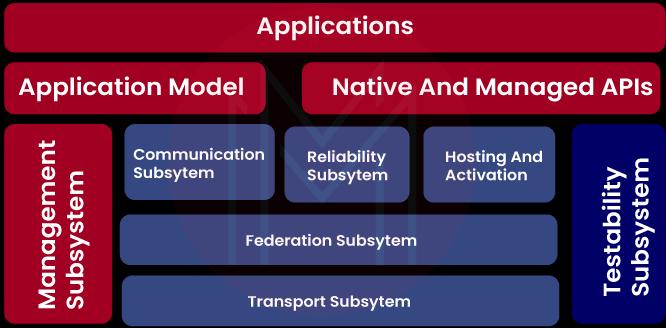- Home
- Blog
- Microsoft Azure
- What is Azure Service Fabric

- Azure Active Directory
- Azure Active Directory B2C
- Azure Active Directory Domain Services
- Azure Analysis Services
- Azure App Services
- What is Azure Application Insights?
- Azure Arc
- Azure Automation - Benefits and Special Features
- A Complete Guide On Microsoft Azure Batch
- Azure Cognitive Services
- Azure Data Catalog
- Azure Data Factory - Data Processing Services
- Microsoft Azure Data Factory Tutorial (2024)
- Everything You Need To Know About Azure Data Lake
- Azure DNS - Azure Domain Name System
- Azure ExpressRoute
- Azure Functions - Serverless Compute
- Azure Interview Questions and Answers (2024)
- Azure IoT Edge Overview
- Azure IoT Hub
- What Is Azure Key Vault??
- Azure Load Balancer
- Azure Logic Apps - The Lego Bricks to Serverless Architecture
- Azure Machine Learning
- Microsoft Azure Media Services
- Azure Monitor
- Introduction To Azure SaaS
- Azure Security Center
- Azure Service Bus
- Overview of Azure Service Fabric
- Azure Site Recovery
- Azure SQL Data Warehouse
- Azure Stack - Cloud Services
- Azure Stream Analytics
- Azure Virtual Machine
- Azure’s Public Cloud
- Microsoft Azure Application Gateway
- Microsoft Azure Certification Path
- Microsoft Azure - Exactly What You Are Looking For!
- Microsoft Azure Fabric Interview Questions
- HDInsight Of Azure
- IS Microsoft Azure Help To Grow?
- Microsoft Azure Portal
- Microsoft Azure Traffic Manager
- Microsoft Azure Tutorial
- Overview of Azure Logic Apps
- Top 10 Reasons Why You Should Learn Azure And Get Certified
- Server-Less Architecture In Azure
- What is Microsoft Azure
- Why Azure Machine Learning?
- Azure DevOps Interview Questions
- Azure Active Directory Interview Questions
- Azure DevOps vs Jira
- What is Azure Databricks?
- Azure Databricks Interview Questions
- Azure Data Factory Interview Questions
- Azure Architect Interview Questions
- Azure Administrator Interview Questions
- Azure Data Studio vs SSMS
- Microsoft Interview Questions
- What is Azure Data Studio - How to Install Azure Data Studio?
- Azure DevOps Projects and Use Cases
- Azure Data Factory (ADF) Integration Runtime
- Azure DevOps Delivery Plans
- Azure DevOps Variables
- Azure DevOps vs GitHub
- Azure DevOps Pipeline
In today’s world, every business consists of the simplest processes to the most complex business, undeniably. The right platform will help developers to develop and deploy applications quickly and effortlessly. As a result, businesses can quickly leverage their applications in a production environment and reap business outcomes. Thankfully, Azure Service Fabric is a platform used to develop and deploy robust applications. Mainly, they support developing applications for microservices and containers.
This blog bags the fundamentals of Azure Service Fabric, its capabilities, architecture, programming models, and many more.
Azure Service Fabric - Table of Content
What is Azure Service Fabric?
Azure Service Fabric is an open-source and distributed system platform. It works based on a Platform as a Service (PaaS) model with which you can quickly build manageable, scalable, testable distributed applications in a single environment. Azure Service Fabric addresses the crucial challenges in managing and efficiently deploying cloud applications. It provides solutions by thoroughly understanding the resource needs for developing applications. Then, it uses the infrastructure resources efficiently and provides solutions to simple to complex business problems. As a result, you can develop advanced multi-tenant SaaS, gaming, and mission-critical applications using this platform.
Mainly, Azure Service Fabric orchestrates containers and microservices effectively. So, you can quickly build, deploy, package, and manage scalable and reliable microservices with low latency. You can restart failed services, manage states, route messages, and monitor the health of microservices using this platform. The significant thing about Azure Service Fabric is that it allows the building of stateful and stateless microservices. As a whole, it simplifies building microservices applications and application lifecycle management.
Before diving deep into Azure Service Fabric, we will learn about microservices. It will help you to understand Azure Service Fabric in a better way.
| If you want to become a Microsoft Azure certified professional, then visit Mindmajix - A Global online training platform: “Azure Certification Training” Course. This course will help you to achieve excellence in this domain. |
What are Microservices?
A microservice is nothing but a small, independent, and scalable service. A microservice consists of codes that can be versioned, scaled, and deployed. Also, they have a separate database and other resources that run independently. Each microservice will have unique URLs with which you can quickly locate them. Besides, microservices provide better consistency and availability regardless of failures.
As you know, monolithic is one of the widely used approaches to run applications. But how do microservices differ from the monolithic approach? Let’s find the difference between the two approaches in the following.
Difference between the Monolithic and Microservices Approach:
In its basic form, a monolithic is a self-contained as well as a single unified unit. It has a single codebase and database that provides all business solutions in one place. It also simplifies application deployment and scaling. On the other hand, microservices are the collection of small and independently deployable services. Every microservice consists of its specific business logic, database, and codebase. Also, they can be updated, deployed, tested, and scaled.
Monolithic services consist of domain-specific functionalities. They can be divided into many functional layers. In a way, it simplifies the complexity of services. On the other side, microservices cannot reduce the complexity of services, but they help to identify issues quickly. Simply put, it enhances visibility across all the services.

The monolithic approach offers many pluses, such as easy application development, testing, deployment, debugging, performance, etc. At the same time, it has many minuses, such as slower speed, low flexibility and reliability, and so on. On the other hand, microservices are no less than monolithic since it has many advantages, such as agility, continuous deployment, scaling, maintenance, reliability, scaling, and many more. Also, it has many drawbacks, such as increased infrastructure costs, organizational overhead, lack of standardization, etc.
What are the Main Capabilities of Azure Service Fabric?
Azure Service Fabric comes with a lot of powerful capabilities. Let’s list them below one by one.
- Azure Service Fabric integrates with many vital Microsoft services such as Azure SQL Database, Cortana, Azure Cosmos Database, Microsoft Intune, Microsoft Power BI, and many more.
- It allows you to deploy applications in moments – no matter the number of applications and size of containers.
- It provides robust application lifecycle management and CI/CD deployment.
- With the help of Azure Service Fabric, you can track, maintain, and decommission applications efficiently.
- Azure Service Fabric offers good portability. It means that Azure Service Fabric can run anywhere on any platform – it doesn’t matter whether it is a public cloud or on-premise server, Windows OS, or Linux OS.
- Azure Service Fabric allows you to quickly get the compliance certifications such as SOC, PCI DSS, HIPAA, ISO, and GDPR.
- With Azure Service Fabric, you can run any application written in any language and built by any programming model.
- Azure Service Fabric offers good scalability. In other words, it can quickly scale up to thousands of nodes or machines.
- It is excellent in container hosting, workload orchestration, and cluster resource management. Know that cluster is a collection of nodes or machines in the Azure Service Platform.
- It performs quick upgrades with zero downtime and allows automatic recovery from failures
- It quickly solves distributed system issues such as failure detection and failover, service recovery, leader election, environment abstraction, application portability, and so on.
- Above all, Azure Service Fabric allows automatic scaling, makes self-healing from faults, and rolls updates regularly.
What are the different Subsystems of Azure Service Fabric Architecture?
The Azure Service Fabric architecture is built-up of many layered subsystems in it. The subsystems are transport, reliability, federation, hosting, testability, management, and communication. And the programming models are placed above all the layers of Azure Service Fabric along with the application model.
Let’s have a look at the subsystems below:
Transport Subsystem: Know that communication is one of the essential elements in clusters. The transport subsystem establishes a secure communication channel between nodes of a cluster or different Azure Service Fabric clusters. It is essential to note that this subsystem follows the request-reply communication pattern. This pattern helps to implement multicast and broadcast communication in the federation layer of the architecture. Not only that, this subsystem ensures the security of communication through X509 certificates and Windows security.
Federation Subsystem: This subsystem sits above the transport subsystem and supports building Azure Service Fabric clusters using many nodes. This subsystem usually builds a ring topology over the nodes. This system allows Azure Service Fabric to detect failures, consistently ensure routing, and execute leader elections. In particular, this subsystem uses a leasing mechanism for detecting failures.
Reliability Subsystem: This subsystem is located above the federation subsystem. It ensures the reliability of Azure Service Fabric using mechanisms such as replicator, resource balancer, and failover manager. The replicator is nothing but a default component and is also known as the fabric replicator. The programming model API uses it to make Azure Service Fabric highly reliable and available. The failover manager automatically redistributes loads in clusters if you add or remove nodes in clusters. The resource manager supports placing service replicas all over failure domains. In addition to that, you can also use the resource manager to ensure that all the failover units are operational.

Management Subsystem: This subsystem manages the lifecycle of applications and end-to-end services. This subsystem used three mechanisms to manage the lifecycle of applications. They are cluster manager, image store, and health manager. At first, the cluster manager manages the lifecycle of applications from provision to decommissioning. It works with the failover manager for placing applications on nodes. And the placement of applications is made based on service placement constraints. Then, the health manager monitors the health of applications, cluster entities, and services. The third one is image store – it is nothing but a storage place used to store and distribute application binaries.
Testability Subsystem: Undeniably, testing codes is a crucial stage in every application development. The testing subsystem helps to test applications before and after deployment. It is a suite of tools with which you can test applications. Using these tools, you can identify faults in codes and validate states and transitions at different stages of the application lifecycle but in a controlled and secure way. Even you can run more extended tests using this subsystem while not losing availability.
Hosting Subsystem: This subsystem supports managing the lifecycle of applications in a single node. This subsystem works with the cluster manager to manage the node. Also, it interacts with the reliability and health components of Azure Service Fabric to ensure replicas are correctly placed and working usually.
Communication Subsystem: This is yet another subsystem that ensures a reliable messaging system within a cluster. This subsystem uses the naming service that manages service names and properties. It's not a surprise this subsystem allows any client s to interact with any node in a cluster easily. As a result, they resolve the service name as well as retrieve service metadata. Also, it allows developers to build applications with a straightforward naming client API.
| Checkout: Microsoft Azure Fabric Interview Questions |
What are the Programming Models of Azure Service Fabric?
You will get the answer in this section if you want to know how to create and deploy applications using Azure Service Fabric. Let's keep on reading.
Azure Service Fabric uses many programming models for building and managing applications. In this regard, Azure Service Fabric APIs help explore the platform’s vital features and application frameworks. Also, they simplify microservices development and management.
Now, we will discuss the various programming models used with the Azure Service Fabric platform.
Reliable Services: It is a lightweight framework used to build services. This framework uses only a few APIs to manage the lifecycle of services. Generally, reliable services are stateless, like web servers. Moreover, they can fully integrate with the Azure Service Fabric platform.
Reliable Actors: It is yet another framework that uses independent units of computes and supports single-threaded execution. Here, the units are called actors. This framework also comes with built-in communication used to connect the actors. Also, this framework provides pre-set state persistence as well as scale-out configurations. Like reliable services, they fully integrate with the Azure Service Fabric platform.
ASP.NET Core: As you know, ASP.NET is an open-source and cross-platform framework. You can use this framework to build cloud-based web, mobile, and IoT applications. This framework integrates with Azure Service Fabric seamlessly and supports building stateful and stateless .NET applications. Further, the Azure Service Fabric orchestration capabilities of Azure Service Fabric play a crucial role if you use this framework to develop applications.

What is Azure Service Fabric Cluster?
Azure Fabric Cluster is a network formed by a group of virtual or physical machines where you can deploy and manage microservices. Every cluster has many vital resources, such as Virtual Machines (VM), virtual networks, VM scale sets, storage accounts, load balancers, and public IP addresses. This is where machines are named cluster nodes. No wonder clusters can scale up to thousands of nodes. You can increase or decrease the number of nodes in a cluster based on its performance. Adding or removing a node in a cluster will rebalance all the replicas and instances across the cluster.
Cluster Security: It’s not a surprise if you might have understood that clusters are the core of the Azure Service Fabric platform. But now, the question is how to secure clusters from cyber-attacks and vulnerabilities altogether. To resolve this, Azure Service Fabric provides fantastic mechanisms to protect the clusters from threats.
Let’s read about the different protection mechanisms to understand them better.
The node-to-node security mechanism ensures secure communication between VMs in a cluster. It allows only authorized VMs to host applications and services in the cluster. Also, Azure Service Fabric uses X.509 certificates to secure cluster traffic and support authentication. You can use self-signed certificates for testing clusters. However, a certificate from trusted sources is recommended to secure clusters. Additionally, you can use Windows security based on group-managed to secure the clusters.
What is Azure Service Fabric Mesh?
Azure service fabric mesh is yet another feature of azure service fabric. Are you interested to know about this fabric mesh? No worries! You can read the following:
Azure Service Fabric Mesh works based on Infrastructure-as-a-Service (IaaS) model. It is a layer used to manage communication between microservices. Undoubtedly, it is one of the suitable communication models for the latest distributed applications. With Software-Defined Networking (SDN) features, this model provides intelligent message routing between microservices. It uses the serverless approach to manage infrastructure smoothly. It provides crucial scalability and visibility across the runtime environment. What's more! This model offers service discovery, load balancing, traceability, encryption, observability, and authentication.
Conclusion:
It’s now time to wrap! Azure Service Fabric is one of the platforms that simplifies building and managing microservices and containers. It offers good scalability, flexibility, portability, and many more. We hope this might have helped you understand Azure Service Fabric's capabilities, architecture, and service fabric clusters in greater detail. The last but important thing is that you can accurately build, manage, deploy, maintain, and upgrade cloud applications.
 On-Job Support Service
On-Job Support Service
Online Work Support for your on-job roles.

Our work-support plans provide precise options as per your project tasks. Whether you are a newbie or an experienced professional seeking assistance in completing project tasks, we are here with the following plans to meet your custom needs:
- Pay Per Hour
- Pay Per Week
- Monthly
| Name | Dates | |
|---|---|---|
| Azure Training | Dec 20 to Jan 04 | View Details |
| Azure Training | Dec 23 to Jan 07 | View Details |
| Azure Training | Dec 27 to Jan 11 | View Details |
| Azure Training | Dec 30 to Jan 14 | View Details |

Keerthi Sai is a Senior Writer at Mindmajix with tons of content creation experience in the areas of cloud computing, BI, Perl Scripting. She also creates content on Salesforce, Microstrategy, and Cobit.















